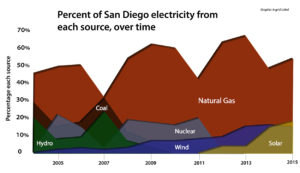Why We Must Drive Less
In San Diego, we’ve come to a crossroads that represents one of the toughest ethical and cultural dilemmas of our generation. Together we agree we want a healthy and equitable future, which includes reducing carbon emissions to curb global warming. But individually we want to keep the freedom and convenience of our personal vehicles.
Today’s luxury of driving is at odds with the forecasts of our future. Whether you want to call it a tragedy of the commons, diffusion of responsibility, or something else… the fact remains, the sum of our individual daily emissions pushes us well past the tipping point of dangerous changes due to climate change.
Given how convenient driving is compared to other options, we can’t blame ourselves for hoping for a silver bullet. Aren’t the challenges we face over exaggerated? Won’t these problems magically be solved with the latest tech invention?
Given the best information we have available to us today, the answer is a resounding ‘No’. Clearing up some of the misconceptions about our cars and our future may help us come to terms with what’s at stake. Here are the three biggest misconceptions about driving in San Diego that threaten our ability to make ethical decisions about the kind of future we want.
Misconception 1: There’s Still Time (I don’t have to decide today)
The latest UN Climate Change Report (2021), put any remaining doubts about the severity of our situation to rest. We’re already past a tipping point that locks us in to 30 years of worsening climate impact… regardless of what actions we take now. At this point, our efforts to reduce emissions will help limit warming beyond 2050, giving us a chance to prevent runaway global temperature rise and the catastrophic climate volatility that would come with it.
The actions we take today will affect our quality of life tremendously in the next 20-50 years. By nature, humans are notoriously bad at planning for the future. Understandably, we focus on immediate threats to our wellbeing rather than hypothetical outcomes in years to come. But we have the tools to make accurate predictions and we are smart enough to know there are some seemingly small things we can do today that have a tremendous impact on our future quality of life.
Divesting in fossil fuel use today will have an unimaginable impact on our environment in 30 years. The leaders who have this foresight and are able to execute on it are what San Diego needs now.
Today we are tasked with a difficult human problem: change our behavior now for a result that we will not see for several years.
Misconception 2: Electric Cars Are The Solution
We want to have our cake and eat it too. This well-known human characteristic is a problematic way of thinking.
Electric vs gas cars is one of these cases. You may be thinking that switching San Diegans to more electric vehicles allows us to have convenience and be environmentally friendly. Unfortunately, there are three problems preventing the transition to electric cars from solving our challenges:
- Power Sources – As clearly visualized in the graphic below, even though renewables are growing, fossil fuels are still the primary source of electricity generation in San Diego.
- Production – The production of electric cars, such as a Tesla, has an equivalent carbon footprint to the production of full-sized internal combustion cars. While the lifetime reduction in carbon emissions from owning a Tesla is estimated at 53% less than a gas-driven vehicle, the resulting emissions are still well beyond what we need to cut to reverse our climate change trajectory.
- Perpetuating Culture – Assuming electric vehicles will solve our carbon emissions worries delays our transition to other transportation solutions that are significantly better methods of reducing emissions.

Misconception 3: Driving Will Still Be Our Core Mode of Transportation
While there are several variables to consider, the high-level concept here is simple. Individual transportation by vehicle is not going to become efficient enough in the next 20 years to make it a viable mode of transportation if we want to curb climate volatility.
To evaluate the efficiency of transportation in terms of carbon emissions, the key metric is the amount of CO2 emitted per passenger per kilometer (or mile). This graph shows how various modes of transportation stack up when it comes to carbon emission per passenger.

This data tells us a few things that you probably already expected to find:
- Cars are near the top, as the worst emitters per passenger
- Cars become more efficient with multiple passengers
- Rail transportation is the lowest emitter per passenger
Source: Statista.com
Yes, there will be differences in location, car size, fuel efficiency, etc. However, regardless of how you slice and dice the variables, you’re going to get the same outcome. Moving more people together, in one vehicle, lowers the energy input to distance traveled. Planes are an exception because of their speed of travel.
Not shown here are modes of transportation that emit no emissions, such as walking or biking.
In Summary
It would be really nice if the solution to the biggest challenge in human history was to switch to electric vehicles. Unfortunately, given the best available data, it is clear that the switch can’t happen fast enough to prevent a climate catastrophe.
We don’t have time to wait for technology to catch up and reduce the impact of driving enough to make it the main mode of transportation for San Diegans. We need to stop driving now, by whatever means possible.

Recent Comments